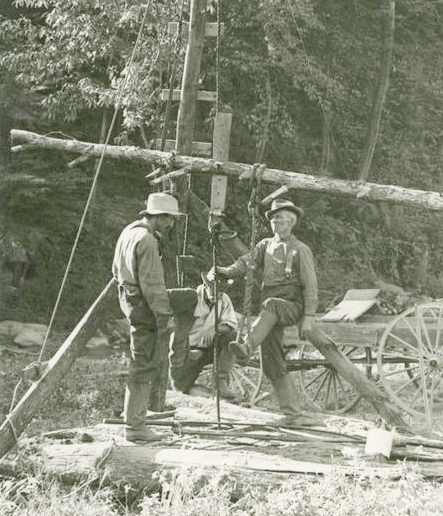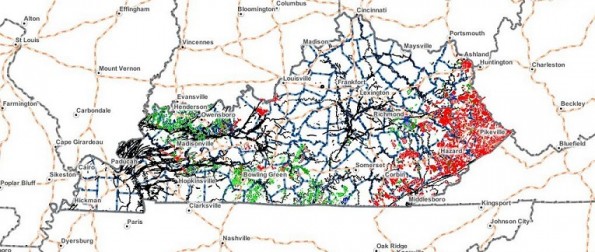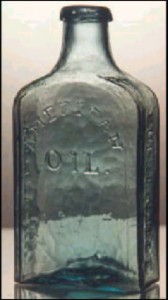Cumberland County pioneers drilled for brine, found oil — and bottled and sold it as medicine.
An 1829 well drilled with a spring-pole seeking brine found oil instead. Petroleum from “Kentucky’s Great American Oil Well” would be bottled and sold for medicinal purposes. Also known as the “Old American Well,” the fortuitous discovery was among the earliest commercial oil wells in the United States.
Although drilling specifically for oil would not begin until three decades later in Titusville, Pennsylvania (see First American Oil Well), the Kentucky well struck a highly pressurized geologic formation, making the failed brine well one of the nation’s first oil gushers.

An 1865 Kentucky State Geology Survey map, “embracing about 16 miles square of Cumberland County,” includes the March 11, 1829, Great American Oil Well — drilled for brine but producing oil bottled and sold for “medicinal” purposes.
Boring for salt brine with a simple spring-pole device on a farm near Burkesville, Kentucky, drillers found oil instead. They had been working for a local doctor when the March 11, 1829, a geyser of oil shot, “to the top of the surrounding trees.”
The Cumberland County well was drilled “using an apparatus consisting of a spring pole made from a strong sapling, set in the crotch of a tree.” The driller manipulated a heavy bit fastened to the free end of the pole by using his foot. It was a slow task requiring frequent stops; as wells got deeper, steam-powered cable-tools came into use (see Making Hole – Drilling Technology).
Pride of Burkesville
An advocate of the Kentucky well’s heritage, the nearby Burkesville Riverfront Lodge Motel has noted in its promotions, “The Old Oil Well led the parade in 1829, and so it will continue to mark the spot where the world’s greatest industry was born.”
Other Kentuckians have agreed with the Burkesville motel’s claim the discovery was the first commercially operated U.S. oil well, predating the famous well in Titusville, Pennsylvania (drilled for oil to make kerosene) by 30 years. The Kentucky Legislature in 1934 erected a historic marker — a large millstone topped by a bronze tablet — with this inscription:
The history and subsequent events of the First Great American Gusher have been kept alive through a few interested citizens who have never, for any length of time, let go this birth of what has come to be a necessary part of the world today.
The 50,000 barrel, Old Oil Well, led the parade in 1829 and so it will continue to mark the spot where the world’s greatest industry was born.

Preceding oil wildcatters, settlers seeking brine drilled with the “spring-pole,” a technology used by the Chinese as early as 450 A.D. Photo from “The World Struggle for Oil,” a 1924 film by the Department of the Interior.
Petroleum drilling, production and control technologies had not been invented. “The salt borers were greatly disappointed,” reported an 1847 account of the discovery. “The well was neglected for several years, until it was discovered that the oil possessed valuable medicinal qualities.”
Oil for Medicinal Purposes
Petroleum’s uses in medicine, which continues today, began as a cure-all bottled in large quantities and “extensively sold in nearly all the states in the Union.”
The 1810-1960 Burkesville Sesquicentennial booklet cites an August 22, 1919, article from the Burkesville Leader newspaper: The well was a continuing puzzle to the curious travelers who succeeded in winding tortuous journey over bed of the creek…There was a reputation as a cure all which spread around among the various adventurers through the years. The fluid was bottled and sold under the caption of “American Rock Oil.”
The writer knew personally, in later years, one man who vouched for its curative powers for baldness. He stated that when he left the oil field on Saturday night he always took his double handful of crude oil and thoroughly douzed his head in it massaging it into his scalp. When he died at the age of 91 he had a beautiful shock of white hair!

Kentucky today has produced oil and natural gas in 52 counties. Oil production (green) is in the western and south-central areas. Most natural gas (red) is in eastern counties. Cumberland County is on the Tennessee border in the middle of the state.
Some claim Kentucky oil ended up in Pittsburgh, Pennsylvania, in the 1840s, where Samuel Kier sold it as medicine. In the mid-1850s Kier refined Pennsylvania oil into a kerosene lamp fuel, which many continued to call “coal oil.”
The historic Kentucky oil well produced until about the Civil War. Salt makers eventually took over the operation of the well, as salt water replaced oil as the well’s primary output.
Ohio Oil Wells
Records gathered as part of a centennial celebration in 1929 “documenting the first commercially operated oil well in the United States” are preserved at the University of Kentucky Special Collections.
However, another even earlier Kentucky well reportedly drilled for brine and found oil. In 1818, Marcus Huling and Andrew Zimmerman drilled for it on Martin Beaty’s land in what is now the Big South Fork National River and Recreation Area in McCreary County and also found oil that was bottled and sold for medicinal purposes.
However, the McCreary County well produced “very little of the useless stuff” and was quickly abandoned and forgotten.
Still earlier, in Noble County, Ohio, drillers seeking brine near Caldwell in 1814 discovered oil — which they soaked up with rags, bottled and sold. The Caldwell Chamber of Commerce and the Ohio Natural Energy Institute (ONEI) have proclaimed: “First U.S. discovery of crude oil from a drilled well was in 1814, Noble County, Ohio.” ONEI added that Ohio’s first commercial oil production began in 1860, followed by natural gas in 1884.
By the early 21st century, more than 275,000 wells had been drilled in Ohio — among the most of all U.S. producing states. Ohio historians also have staked a claim for the petroleum industry’s earliest offshore wells (see Ohio Offshore Wells).
Kentucky petroleum has come from 52 out of its 102 counties — often from rock formations dating from the Cambrian to Pennsylvanian ages, mostly from the state’s western and south-central regions. Significant natural gas fields also have been found in eastern counties. Almost 1,000 wells were drilled in 2009, including 304 dry holes.
On the courthouse grounds in Whitley, a 1979 Kentucky Historical Society marker commemorates the McCreary County oil gusher, drilled about 100 miles to the west 150 years earlier.
Hired by Pennsylvania Rock Oil Company founder George Bissell to drill for oil — not brine — near Titusville, Pennsylvania, Edwin L. Drake launched the U.S. petroleum industry in August 1859.
_______________________
Recommended Reading: Trek of the Oil Finders: A History of Exploration for Petroleum (1975); The Birth of the Oil Industry (1938); A Geophysicist’s Memoir: Searching for Oil on Six Continents (2017).
_______________________
The American Oil & Gas Historical Society preserves U.S. petroleum history. Please become an AOGHS annual supporter and help maintain this energy education website and expand historical research. For more information, contact bawells@aoghs.org. © 2025 Bruce A. Wells.
Citation Information – Article Title: “Kentucky’s Great American Oil Well.” Authors: B.A. Wells and K.L. Wells. Website Name: American Oil & Gas Historical Society. URL: https://aoghs.org/petroleum-pioneers/kentuckys-great-american-well. Last Updated: March 10, 2025. Original Published Date: March 10, 2014.




